Fringe Vocabulary: How to Select and Not Neglect
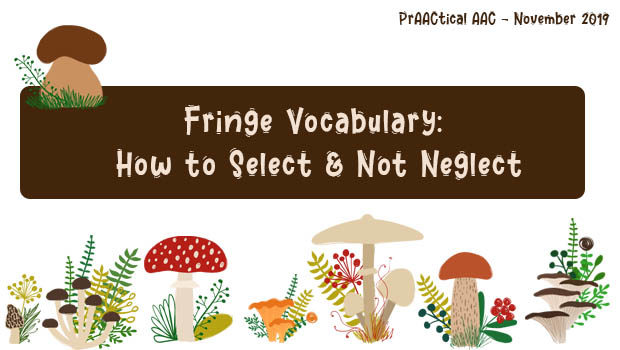
When  we first started writing about core vocabulary, it was partly because most of the AAC systems we came across in our clinical work were heavy on nouns and/or prestored messages. Now that core vocabulary plays a more central role in so many AAC systems, it’s important that we not lose sight of the important role that fringe vocabulary plays for the vast majority of people with AAC needs. In today’s post, guest author Susan Todd, a doctorate student focusing on AAC at the University of Kansas, shares thoughts and strategies for selecting fringe words. An SLP, Susan practiced for four years in outpatient setting completing AAC evaluations and implementing AAC interventions. Susan is also the author and creator of AACtualTalk, a blog aimed at providing advocacy and education in the area of AAC.
we first started writing about core vocabulary, it was partly because most of the AAC systems we came across in our clinical work were heavy on nouns and/or prestored messages. Now that core vocabulary plays a more central role in so many AAC systems, it’s important that we not lose sight of the important role that fringe vocabulary plays for the vast majority of people with AAC needs. In today’s post, guest author Susan Todd, a doctorate student focusing on AAC at the University of Kansas, shares thoughts and strategies for selecting fringe words. An SLP, Susan practiced for four years in outpatient setting completing AAC evaluations and implementing AAC interventions. Susan is also the author and creator of AACtualTalk, a blog aimed at providing advocacy and education in the area of AAC.
::::::::::::::::::::::::::::::::::::::::::::::::::::::::::::::::::::::::::::::::::::::::::::::::::::::::::
Fringe Vocabulary: How to Select and Not Neglect
Core vocabulary gets a lot of attention in the AAC world. A quick Google search gives clinicians, parents, and caregivers many options of structured programs like 1) “Core Word of the Week,” and 2) core words for free core word calendars. This is excellent! Core words are a highly-researched set of words that comprise 80% of typically spoken language. Core vocabulary contains words that can easily be transferred to different environments and be used for multiple different communicative functions.
But, that other 20% (typically referred to as fringe vocabulary) of words are really important. Fringe vocabulary allows for personalization of the AAC system, stakeholder buy-in, and communicative competence. When writing goals, client-specific fringe vocabulary should be included.
There are some barriers to fringe words. Fringe words can require more programming time than core words and collaboration necessary to make appropriate and client-specific fringe vocabulary selections takes precious time. Here are some ideas to guide your thinking and team discussions when selecting fringe vocabulary targets:
- Family culture: Talk to family members. Observe the way the family interacts and what vocabulary parents or caregivers use
- Example: I worked with a family from Texas. Parents and siblings of the AAC user frequently said “Y’all,” and parents expected verbal children to respond to directives from parents with “Yes ma’am,” or “Yes sir.” Adding this vocabulary helped the AAC user to talk like his/her
- Family Community: Where does the family go? What does the family like to do?
- Example: Making sure that religious vocabulary is present for the AAC user to participate meaningfully in the family’s religious practices, or asking the family if they have a hobby they do together (i.e. spending weekends at the lake, yearly camping trips, or a season pass to the zoo).
- Age-appropriate vocabulary: Observe the way peers of the same age interact. What vocabulary are they using? How do they greet one another? What jokes do they make? How do they show off? What slang are they using?
- Example: Within an AAC group, I taught the word “ta-da,” to a group of elementary school AAC users. They absolutely loved the magic tricks I taught them and using the word to show off for friends.
- Academic or professional vocabulary: What vocabulary will help the AAC user participate meaningfully and promote inclusion in classroom settings?
- Example: A child participating in a science class may need some access to vocabulary specific to the lesson in order to participate meaningfully in class.
- Interests of the user: What kind of books does the individual like? What kind of food does the user prefer? What is his/her favorite music? What’s his/her favorite character?
- I think that this is initially what is programmed into AAC systems. Food is sometimes a major reinforcer or asking for a favorite movie. Don’t let your fringe programming/education stop there.
The biggest thing to remember, is that vocabulary targets need to be developed by a team so that vocabulary is meaningful across environments. Parents or caregivers need to have a voice in determining what vocabulary targets would make a meaningful change in the home environment. Maybe the target is bossing a sibling or participating in a silly song with a parent. Maybe it’s learning to use “Alexa” or “Siri” to turn on a favorite song. Maybe instead of sending home core-word of the week home every week of the month, you instead send home a fringe word target one week of the month and core the other three.
Communication is about relationships. I think about my relationships and how communication affects them. For example, I have a slight accent drawing out single-syllable words and saying “crick” for “creek,” and so does my family. What would it be like to not sound like my family? My friends and I became friends through common interests.
Some of the moments I will always remember in AAC intervention come from the AAC user’s meaningful use of fringe vocabulary. For example, the time an eleven-year-old boy activated his eye gaze system to make the fart noise I had programmed in front of the CEO. Or the time a parent sent me a video of her son independently asking Alexa to play his favorite song “Baby Shark” and doing the dance in the kitchen. Or the time when a user independently walked into my room and said “Beyoncé!” These are treasured memories that we want to promote.
For additional ideas about selecting vocabulary targets, check out this article. It gives wonderful examples of how teams created individual vocabulary targets including core and fringe vocabulary for two different AAC users.
References
Bean, A., Cargill, L. P., & Lyle, S. (2019). Framework for Selecting Vocabulary for Preliterate Children Who Use Augmentative and Alternative Communication. American Journal of Speech-Language Pathology, 28(3), 1000–1009. https://doi.org/10.1044/2019_AJSLP-18-0041
Filed under: Featured Posts, PrAACtical Thinking
Tagged With: fringe vocabulary
This post was written by Carole Zangari

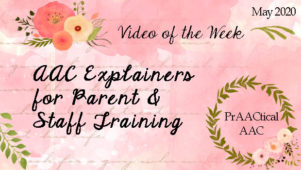
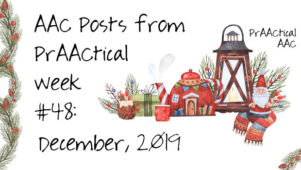
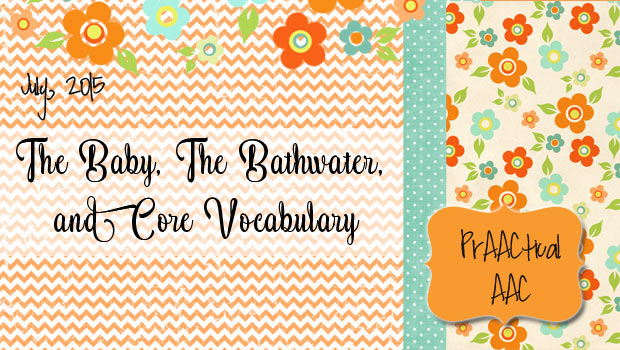
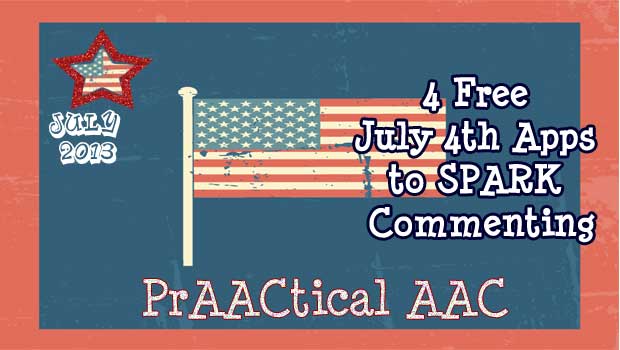
2 Comments
I’ve started routinely sending home a vocabulary questionnaire to families and also have the team at school fill one out so that relevant and important fringe words start getting added to a device ASAP. I generally use the ones in this article: https://praacticalaac.org/praactical/praactical-resources-vocabulary-selection-questionnaire/
Those are awesome resources!